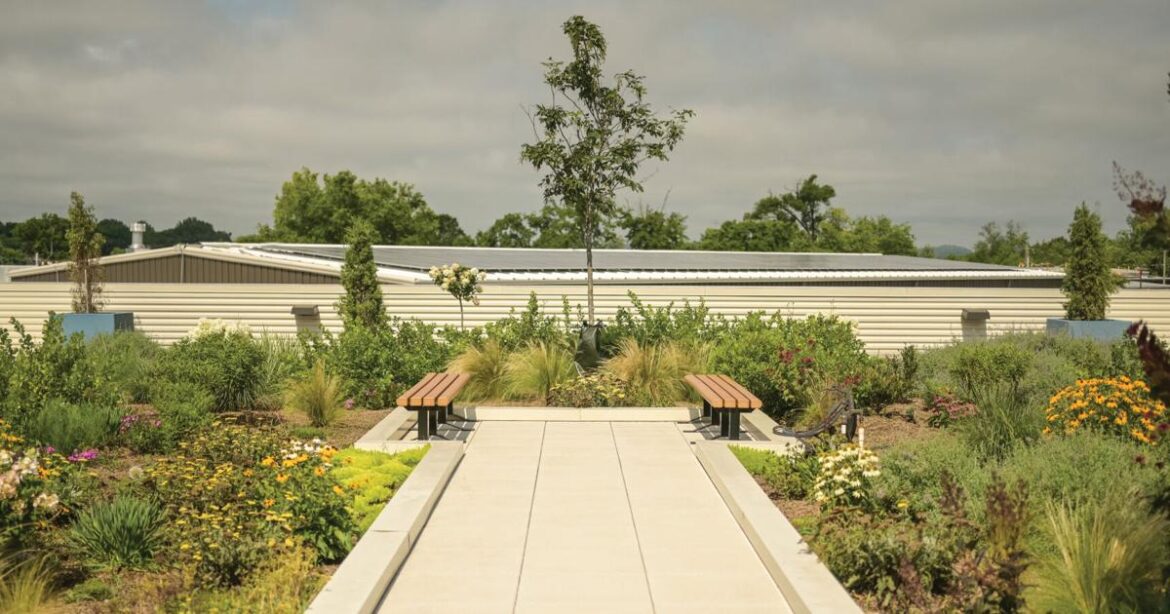On a balmy morning, along a bend in the Cumberland River, a serene garden of native plants and grasses sways with the gentle breeze. Bright blooms of yellow yarrow, pink foxglove and purple catmint wave below a billowing flag of red, white and blue. As summer continues to set in, milkweed and coneflowers will bloom, and with them, butterflies will arrive. Standing in this lush and lovely landscape, if you squint really hard, maybe you could imagine yourself among private parterres inside an Impressionist painting.
Actually, the raised beds of this native-plant ecosystem reside on the second-floor roof of Metro Water Services’ Stormwater division, and you’re welcome to visit.
Located atop building B of the Stormwater Demonstration Campus on County Hospital Road, this fertile green roof — now in its second summer — is just one tool in Metro’s show-and-tell approach to mitigating stormwater runoff in a time of unprecedented development.
Natural Solutions
“When we paved paradise and put up a parking lot, there was nowhere for the water to go,” says Julie Berbiglia, education specialist at Metro Water Services. The consequences of excessive water runoff include flash flooding and pollution, so Metro educates homeowners, builders and developers to improve water quality and reduce the volume flowing from impervious surfaces into waterways.
“Using natural solutions is what we’re promoting,” says Julie, looking out over the second-story garden, where plants soak up rainfall and provide a pollinator pathway for birds and insects.
In the parking lots surrounding the buildings, bioretention ponds capture runoff from pavement, much of which is already pervious. Lush low areas of the ponds are landscaped with native grasses, trees and plants that like “wet feet” and can handle soggy soil, while pooled water filters into the ground. Meanwhile, gabion baskets — wire-mesh containers filled with rocks — slow the flow of water through the ponds to minimize erosion.
Inside the building, a 10,000-gallon cistern collects water from the roof for nonpotable uses. Along County Hospital Road, as many as 500 newly planted trees soak up stormwater runoff between Metro Water Services and the nearby Cumberland River.
Homegrown Progress
“All are things that people can mimic at home,” Julie says, listing rain gardens, rain barrels, native plants and trees among homeowner strategies to mitigate water runoff from residential properties.
Metro Water Services collaborates with University of Tennessee Extension to promote Tennessee Smart Yards, a program of nine principles to support healthy landscapes. Homeowners who meet guidelines related to selecting native plants, managing soils and pests, composting, watering efficiently, fertilizing appropriately, mitigating stormwater runoff, and protecting wildlife and waterways can earn certification, along with a metal sign designating their property a Tennessee Smart Yard.
While new building codes require engineering to keep the first inch of rainfall on a property, longtime residents of legacy properties can take steps to reduce the strain on stormwater systems. “Any water that you keep on your property is water that doesn’t become runoff adding to flash flooding and pollution,” Julie says.
Tips for reducing quantity and improving quality of stormwater runoff:
Clean up after pets in your own yard, not just when out walking.
Keep an eye on storm drains. Clear them or call Hub Nashville for help.
Follow the Tennessee Smart Yards checklist.
Build rain gardens and retention pools. Cumberland River Compact offers instruction materials and on-site consultations.
Install rain barrels to capture and redirect roof runoff.
Install permeable paving.
Plant trees.

